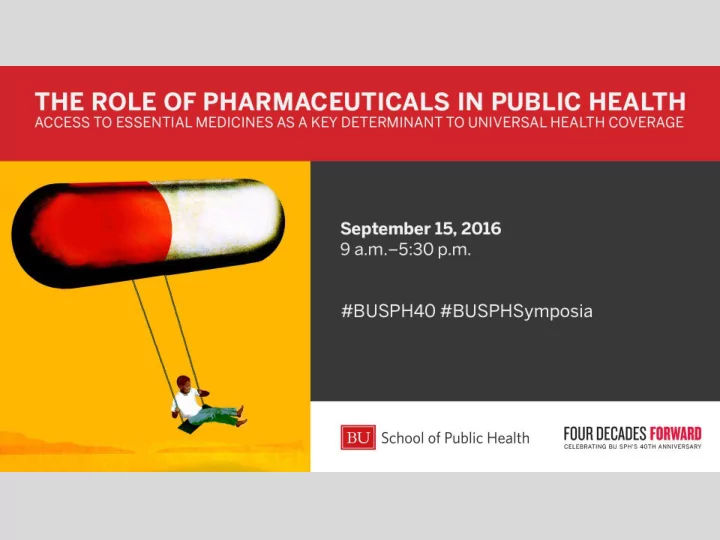

Health Reform in China, Universal Health Coverage, and Access to Medicines Ye Lu Ph.D, Professor School of Public Health, Fudan University lye@fudan.edu.cn Dean’s Symposium The Role of Pharmaceuticals in Public Health Boston University School of Public Health September 15, 2016
• Universal health coverage even in large country like China can be implemented with strong political will.
5 Reform Pillars in China Since 2009 Speeding up medical security system Establishing national essential medicine system Improving grass-roots health service system Promoting equalization of public health service Piloting public hospital reform 4
National Essential Medicine System • Establishing a mechanism for list selection 307 products at primary healthcare level in national EML ( 2009 ) • 520 products at primary healthcare level in national EML ( 2012 ) • Supplemented at provincial level Included in reimbursable drug list • • Improving access to essential medicines • Bidding purchase and uniform distribution at provincial level • “government run health care institutions at grass-roots levels shall sell drugs with zero mark up” • Essential medicines will be insured, “with the reimbursing rate much higher than that of non-essential medicines” • Promoting rational use of essential medicines • Introducing clinical guidelines and formulary
China’s recent progress and efforts in achieving UHC Government input on health care reform • – USD124billion of additional public spending for the 1 st three years • half (USD62billion) was allocated to subsidize premiums for people to enroll in insurance schemes a third (USD41.3 billion) was used to strengthening the primary care • delivery system • The rest to paying the recurrent expenses of basic public health services Improvements of some key indicators (2008-2015) • – The average life expectancy73.1 → 76.3 – Maternal mortality rate: 34.2→21.7/100,000 – Infant mortality rate: 14.9‰→ 8.9‰ Financial protection • – Population coverage to 97% – Benefit package fully expanded to outpatient, inpatient reimbursement rate to 70%, – OOP/THE: 40%→ 30%
• It has achieved universal population coverage, however the service coverage and risk protection still have much to be done.
• Government insufficient reimbursement to hospital( Zero mark up policy) may affect the quality
Government financial subsidy for hospitals in 2012(million yuan) Average revenue Average government Average government per institute financial subsidy per subsidy as percentage of institute total revenue(%) Hospital 67.41 5.13 7.61 Public hospitals 109.5 8.93 8.16 Tertiary hospitals 553.20 37.72 6.82 Secondary hospitals 83.63 7.85 9.39 Primary hospital 10.13 1.47 14.51 Public general 205.66 15.28 7.43 hospitals Ministry hospitals 2642.61 165.84 6.28 Provincial hospitals 979.26 71.81 7.33 Hospitals of 347.73 25.60 7.36 prefecture cities Hospitals of county 121.82 8.67 7.12 level cities County hospitals 84.51 7.16 8.5
• Medicine pricing is critical issues dwell the whole process and the pricing negotiation for innovative medicine base on the pharmaceconomic has to be the way forward for big country
Thank you !
Recommend
More recommend